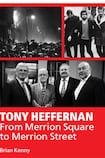
In early 1972, Tony Heffernan was outside the British embassy, then located on Merrion Square in Dublin, protesting at the massacre of civilians in Derry on Bloody Sunday. At the time he was a member of the Official IRA, and although he denies any part in the burning of the embassy, he had no qualms when it took place.
Twenty-two years later, he was in Government Buildings, on Merrion Street nearby, as assistant government press secretary, representing the views of the shortlived Democratic Left party, which was in coalition with Fine Gael and Labour.
It was quite a journey, although he was by no means the first, or the last, member of a paramilitary organisation to take a different path and end up in the corridors of power. There are times, indeed, when it seems like an essential CV entry for a fairly high proportion of Irish political figures.
Fast-forward another 17 years and the former IRA volunteer is media spokesman for the successful presidential campaign of Michael D Higgins, trying "desperately hard to get him to speak in short sentences and to be conscious that RTÉ's 6.01 News will only be looking for a 20-second soundbite".
If the peace process is about turning people away from deadly instruments such as the Armalite and AK-47 towards an exclusive focus on the ballot paper, then Heffernan is a prime example of this.
It is not clear whether his change of view was the fruit of in-depth study and analysis or the product of the bloody, hate-filled feuds between the Officials (“Stickies”), the Provisional IRA and the Irish National Liberation Army (INLA). One suspects that both factors were important.
Heffernan’s family background in the Dublin district of Goatstown was modest. His father, Pat, died of cancer when Tony was five, and his mother, Kitty, was left with seven children, aged from three to 14, and a State pension of 30 shillings a week to rear them.
Heffernan recalls: “I remember pestering her for money to go to the cinema one weekend when I was 11 or 12, and she was reduced to tears, telling me: ‘I just don’t have it.’ ”
He attended the illustrious but at the time fairly strict Synge Street CBS secondary school, where he finished up in the C class in sixth year with Eddie Jordan, who would go on to make his name in motor racing and be awarded an OBE. So much for streaming according to perceived ability.
“When I left school, maybe three out of 33 in my class went on to third level,” Heffernan remembers. Then, aged 18, he took up a position as a clerk, processing orders at an oil company in Harold’s Cross.
Stirring times
The late 1960s were stirring times: the ballad scene in clubs and pubs was at full roar, students were rioting in Paris, the Vietnam War aroused worldwide anger and the civil-rights movement in the North was having a huge impact.
Like so many, Heffernan got caught up in “revolutionary” politics, in his case the Pearse cumann of Sinn Féin, whose members also included the left-wing ideologue Roy Johnston and the IRA leader Cathal Goulding.
He tells Brian Kenny, the author of this book: "By early 1969 I had joined the IRA. I put myself forward and said I wanted to enlist." Apart from a Dad's Army -type sojourn in Co Leitrim during the tormented summer of 1969, his IRA activities, at least according to this account, were limited in scope.
When the inevitable split came between the Officials and the Provos, Heffernan chose the former. In August 1971, he was appointed joint general secretary of Official Sinn Féin. In time, the party was renamed Sinn Féin the Workers’ Party; then it dropped the Sinn Féin prefix. The Official IRA had meanwhile declared a ceasefire, but there were recurring reports that it was engaged in other activities, especially illegal fundraisin g (for example, by producing counterfeit banknotes).
The Workers’ Party won an impressive seven Dáil seats in the 1989 general election. But, dogged by accusations of nefarious Official IRA activity behind the scenes, six of the seven Dáil deputies broke away in 1992 to form what was eventually known as Democratic Left.
Democratic Left was later to merge with Labour, but in the meantime the party enjoyed a stint in government as part of the 1994- 7 r ainbow c oalition . As assistant government press secretary, Heffernan came to be respected by political correspondents, who found him helpful, reliable and honest. Inevitably, though, the journalists complained that he was “a lot more helpful in opposition”.
That was his only stint in government, and there was general surprise, not least on the part of the Tánaiste and Labour leader, Eamon Gilmore, when he did not return to Merrion Street as a Labour spokesman when the current Coalition was formed. "At the end of the day I was confident it was the right thing to do," Heffernan says.
This slim volume is rich in anecdote and insight, and is a must-read for anyone interested in the activities of the low-profile folk behind the scenes who play such a crucial role in Irish politics.
This l imited- circulation book is available from Books Upstairs, on College Green, Dublin 2, or from Brian Kenny at kennybj@eircom.net










